
|
 |
deel 2 |
Friday 10 May 2019
We get up at 8 and have breakfast at the hotel. After breakfast we walk to Bike
Asia to pick up our bikes. We want to do a bike ride through the
valley of the Yulong river. For Erik there is a 23 inch model,
for me a 21 ”. We first cycle to the Starbucks for coffee. Then we head
for the Yulong River. We ride on cycle routes along tiny canals, through
forests and through rice fields. After an hour we arrive at the Yulong
and follow it more or less in the direction of the Jinlong bridge. The
landscape is beautiful with beautiful overgrown mountains and rice
fields in which the farmers are working. Cattle provide the power for
plowing. We let the drone take off a few times to make beautiful images
of the karst mountains, the rice fields and the Yulong river. At one
point this leads a group of women passing by on the scooter taking an
interest. They make selfies with us in the background.
at the hotel. After breakfast we walk to Bike
Asia to pick up our bikes. We want to do a bike ride through the
valley of the Yulong river. For Erik there is a 23 inch model,
for me a 21 ”. We first cycle to the Starbucks for coffee. Then we head
for the Yulong River. We ride on cycle routes along tiny canals, through
forests and through rice fields. After an hour we arrive at the Yulong
and follow it more or less in the direction of the Jinlong bridge. The
landscape is beautiful with beautiful overgrown mountains and rice
fields in which the farmers are working. Cattle provide the power for
plowing. We let the drone take off a few times to make beautiful images
of the karst mountains, the rice fields and the Yulong river. At one
point this leads a group of women passing by on the scooter taking an
interest. They make selfies with us in the background.
We get off our bikes at the Jinlong bridge. The lady from Bike Asia is
also there (coincidentally) and takes our bikes. They go on a truck to
Xiatang. We first have lunch at an eatery. Rice noodles wit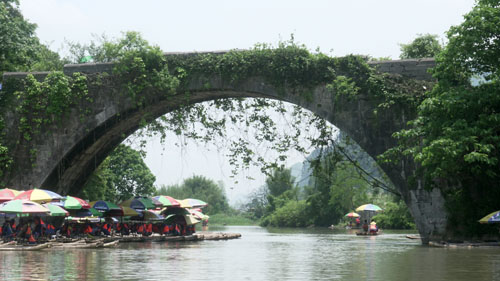 h
duck and chicken for 20 Yuan (€2.40/US$2.65) for the both of us. Then we
step on a bamboo raft with a punt, which takes us downstream. There are
5 rapids that we have to go through. Feet up or they will get wet! We
slowly float down the river for about an hour and a half. We get out in
Xiatang where our bikes are waiting for us. We buy the photo that was
taken of us on the river. From XiaTang we follow the route that we came
on, back to Yangshuo.
h
duck and chicken for 20 Yuan (€2.40/US$2.65) for the both of us. Then we
step on a bamboo raft with a punt, which takes us downstream. There are
5 rapids that we have to go through. Feet up or they will get wet! We
slowly float down the river for about an hour and a half. We get out in
Xiatang where our bikes are waiting for us. We buy the photo that was
taken of us on the river. From XiaTang we follow the route that we came
on, back to Yangshuo.
In the evening we first eat something from a street vendor. I take meat
skewers and Erik a kind of Chinese falafel. After that we eat in a
restaurant, but that was less of a success. A lot, but not especially
tasty. We drink coffee at our regular address, a nice man a few blocks
from our hotel, who always seems to have to look after his toddler
daughter. The coffee takes a lot of time to make, but the friendliness
of the cafe owner compensates a lot.
Weather: 26 degrees and sun
Saturday 11 May 2019
We We get up at 6.30 am and have breakfast as soon as the kitchen opens
at 7.30. At 8 o'clock the taxi picks us up and takes us to the high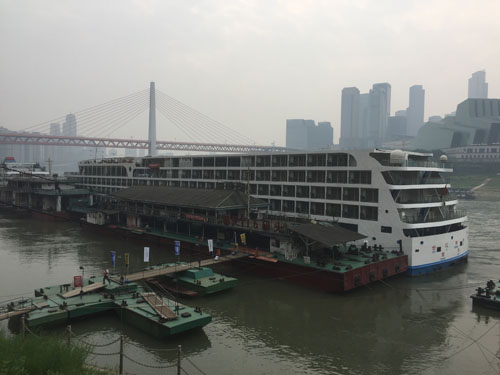 speed train station of Yangshuo which is almost 30 km away at Xing Ping.
It takes almost 50 minutes before we get there. This time the access to
the station is a bit more relaxed. Only a passport and baggage check.
Click here for a video about arrival and departure at Yangshuo station.
speed train station of Yangshuo which is almost 30 km away at Xing Ping.
It takes almost 50 minutes before we get there. This time the access to
the station is a bit more relaxed. Only a passport and baggage check.
Click here for a video about arrival and departure at Yangshuo station.
It is a long train journey. We leave at 10:00 am and arrive in Chongqing
West at 3:07 pm. That is a fairly large station, but we do not see any
shops at all. We walk to the taxi stand in the underground parking.
There is a long line of people waiting. We get our ride after about
fifteen minutes waiting. The taxi ride to the port where the river ships
depart from, for the three-day cruise on the Yangtze River takes about
50 minutes. The driver rushes through the traffic, making phone calls,
singing songs and overtaking left and right. We arrive at the quay
without any problems. Then the search for the right ship. We were told
by telephone by the operator that the ship would be at Pier 3, but that
is not the case. Turns out to be 6. We have to walk even further, as the
even numbered piers are on the opposite side from the odd ones. There
are two ships at pier 6, but we don't realize that and we're going on
the wrong ship.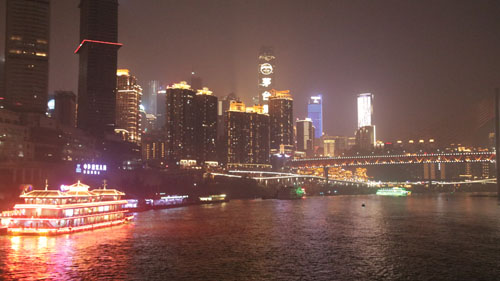 The misunderstanding is clarified, and we are accompanied to the right
ship, the Gold
7.
The misunderstanding is clarified, and we are accompanied to the right
ship, the Gold
7.
When we board there the staff is still getting instruction – or being
drilled - and we have to wait a while before we get the key to our
cabin. It is a large ship with 6 decks. Around 5 p.m. we can unpack in
our cabin. We booked the cruise through Travelchinaguide.com.
We buy a supplement for dinner, so that we get a private table in the
VIP restaurant. Tonight there is no dinner, but we have some dried soup
with us, on which we can pour hot water.
At 9.30 pm the Gold 7 sets off and our cruise starts. We sail through
Chongqing, a modern and large city with lively illuminated signs and
light shows on the facades of large buildings.
Weather: 25 degrees, cloudy. In Chongqin hazy.
Sunday 12 May 2019
We wake up when the ship arrives in Fengdu. This old city has
disappeared under water as a result of the construction of the Three
Gorges Dam. The new city has been rebuilt at a higher level. We go to
the Ghost City, a sanctuary dedicated to the final judgment and the
journey to hell or heaven. Once on land we go with electric cars to the
entrance building. That is, like so often 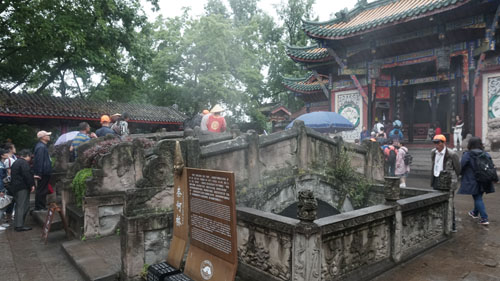 in
China, very chaotic. The Chinese only think of themselves and do not
want to wait for someone who's turn it is to get in. Eventually we all
arrive at the main entrance. All that pushing does no one any good, but
everyone is doing it. We quickly learn not to take part in the rat race.
Our guide speaks some English, but it is not always easy to understand.
We transfer to a cable car that takes us up to the temples and palaces.
We are told a story about the sanctuary. One of the parts is a bridge
that you have to cross. Guardians judge good and bad people. We may of
course continue, otherwise would have been tipped off the bridge. A long
series of temples follows with beautiful Buddha statues and also statues
of guards, evil spirits and much more. The view over the Jangtze is also
beautiful to see. The guide speaks through a microphone and a speaker,
but all other guides do that too. A true cacophony of guides is the
result. The Chinese visitors will not be very quiet either. At the end
of the complexis a tower, the last point from which the dying people
could see their surviving relatives. We also see here a gallery with
statues that depict the torture, that the people have to
in
China, very chaotic. The Chinese only think of themselves and do not
want to wait for someone who's turn it is to get in. Eventually we all
arrive at the main entrance. All that pushing does no one any good, but
everyone is doing it. We quickly learn not to take part in the rat race.
Our guide speaks some English, but it is not always easy to understand.
We transfer to a cable car that takes us up to the temples and palaces.
We are told a story about the sanctuary. One of the parts is a bridge
that you have to cross. Guardians judge good and bad people. We may of
course continue, otherwise would have been tipped off the bridge. A long
series of temples follows with beautiful Buddha statues and also statues
of guards, evil spirits and much more. The view over the Jangtze is also
beautiful to see. The guide speaks through a microphone and a speaker,
but all other guides do that too. A true cacophony of guides is the
result. The Chinese visitors will not be very quiet either. At the end
of the complexis a tower, the last point from which the dying people
could see their surviving relatives. We also see here a gallery with
statues that depict the torture, that the people have to  endure,
who have led a bad life. That looks horrible. After three hours we go
down again.
endure,
who have led a bad life. That looks horrible. After three hours we go
down again.
We take a break and then it's time for lunch. In the afternoon there is the welcome party where the captain introduces himself and his officers. He speaks (in Chinese only) and brings out a toast. Then he walks around the room to toast with everyone. The next part is a dance performance by a members of the crew. The men in gala, the ladies in tutu. It looks a bit bizarre. All this is rounded off with a polonaise for everyone who feels like it.
Then it's time for the lottery. That is definitely our cue to go to the cabin. We take it easy and watch the landscape pass by. Around five o'clock we moor for the optional evening excursion. A light, song and dance show. We pass, because we've seen something like that in Yangshuo.
We dine in the VIP lounge again and order a wine. They do not have red
wine, but they do have white wine, which is quite pricy, also for Dutch
standards (€ 55). It is served lukewarm. Apparently, there is no real
wine culture here yet.
Weather: 22 degrees. Rain showers in the morning. Dry later.
Monday 13 May 2019
After breakfast we can relax in the cabin. We do not participate in the
optional morning excursion. Around noon we are summoned to the Sun Deck for a look at the first of the three gorges in the
Yangtze River, the Qutang gorge. Unfortunately, it is raining,
but it is a beautiful sight. Then we have lunch. We moor in Wuhan in the
afternoon. There we transfer with an English speaking guide (Mike) to a
smaller boat, which sails into a branch off the Yangtze through the Three
Lesser Gorges. These are also very beautiful to see. On board it
is a clamour of sound. Each group has its own guide with an amplifier.
In addition, the boat also has a announcer, who is incredibly verbose.
And the screaming Chinese passengers. Strangely enough, you do not hear
anything of this on the right aisle, so we prefer to be there. We pass
the hanging coffin, a coffin of an ancient culture, which, after death,
hid its princes here in caves high in the mountains. After the third
small gorge, the emerald-coloured gorge, we arrive at a jetty, where
some of the passengers transfer to an even smaller boat for a trip
through the mini gorges. We don't do that. In return, we get a soothing
rest and enjoy the surroundings. When the crowd returns,
to the Sun Deck for a look at the first of the three gorges in the
Yangtze River, the Qutang gorge. Unfortunately, it is raining,
but it is a beautiful sight. Then we have lunch. We moor in Wuhan in the
afternoon. There we transfer with an English speaking guide (Mike) to a
smaller boat, which sails into a branch off the Yangtze through the Three
Lesser Gorges. These are also very beautiful to see. On board it
is a clamour of sound. Each group has its own guide with an amplifier.
In addition, the boat also has a announcer, who is incredibly verbose.
And the screaming Chinese passengers. Strangely enough, you do not hear
anything of this on the right aisle, so we prefer to be there. We pass
the hanging coffin, a coffin of an ancient culture, which, after death,
hid its princes here in caves high in the mountains. After the third
small gorge, the emerald-coloured gorge, we arrive at a jetty, where
some of the passengers transfer to an even smaller boat for a trip
through the mini gorges. We don't do that. In return, we get a soothing
rest and enjoy the surroundings. When the crowd returns, 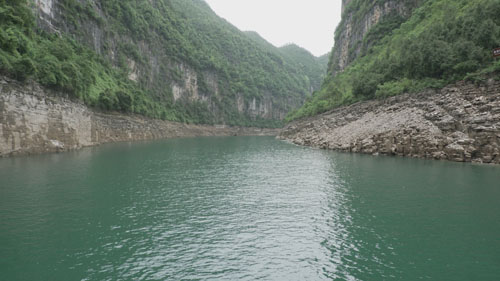 the
pandemonium starts again.
the
pandemonium starts again.
Back on board, our Gold 7 leaves soon. We get to see the second gorge,
the Wu gorge. After this we have to go to the table again for
dinner. This time not with two of us, but with seven others at a large
round table. Fortunately, they have teamed us up with the most sedate
and courteous Chinese people we have seen so far. One specialty after
another is placed on a turntable in the middle of the table and you can
turn your desired dish towards you and scoop it on your plate. If
something runs out, a new dish is added without delay. The dinner only
lasts 40 minutes, so we have to eat fast.
After dinner we have to pay for the drinks we had on the cruise. Then
the party evening starts with the talent show. We pass up on that and
retire to the cabin with the bottle of wine we saved from last night.
Weather: cloudy and rain showers. 19 degrees
Tuesday 14 May 2019
We get up early. Disembarkation awaits us after breakfast.
Disembarkation is a complete chaos. Far too many people gather in the
lobby area. We move to the buffet restaurant to await developments. Our
English-speaking guide CiCi meets us there. After a while we can take a
cable car from the pontoon to the quay, where buses are waiting for us.
We find the right bus and take a seat. The drive to the Three Gorges Dam
takes half an hour. The dam is a bold example of Chinese Civil
Engineering. 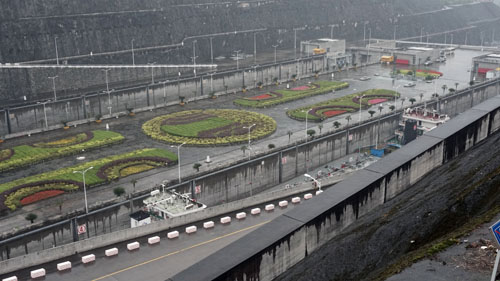 Construction
started in 1993 and was not completed until 2003. Due to the dam, the
water level in the Yangtze has risen by around 100 meters, so that
entire cities have disappeared into the water. 1.3 million people had to
be relocated. It is expected that within 10 to 15 years another 4
million people will have to relocate because the river banks are
calving off and more cities will disappear into the water. The river is
now easier to navigate and the power plant supplies 22.5 GW of power and
provides 3% of the total Chinese electricity consumption. Along the dam
runs a two-way ship's ladder, for freight traffic. Each staircase has
five locks. This was completed in 2015. The dam rises to 185 metres
above sea level.
Construction
started in 1993 and was not completed until 2003. Due to the dam, the
water level in the Yangtze has risen by around 100 meters, so that
entire cities have disappeared into the water. 1.3 million people had to
be relocated. It is expected that within 10 to 15 years another 4
million people will have to relocate because the river banks are
calving off and more cities will disappear into the water. The river is
now easier to navigate and the power plant supplies 22.5 GW of power and
provides 3% of the total Chinese electricity consumption. Along the dam
runs a two-way ship's ladder, for freight traffic. Each staircase has
five locks. This was completed in 2015. The dam rises to 185 metres
above sea level.
There is a good chance that the depositing of sediments will be
disturbed and the reservoir will eventually clog up. Moreover, there is
no longer any fertile sludge arriving in the lower reaches of the river.
Finally, the flooded factories and homes pollute river water, which is
no longer drinkable and also no longer suitable for swimming or fishing.
It is raining heavily and relentlessly. Cici does her best to keep the
group together, which is not easy. It is very busy. First we have to go
through a security check. Our suit cases must be taken out of the
luggage compartment and run through the scanner. But we can leave
prohibited items on the bus, such as knives and spray cans. 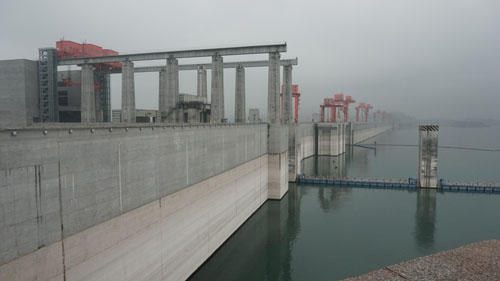 My
drone is intercepted in the scan and I am not allowed to take it with
me. It will be kept in storage for the duration of the visit. A little
later we are on the bus again and so are the knives and spray cans! Then
to the viewpoint for the ship's ladder. From there we go with an
electric car to the viewpoint for the dam itself. There again a chaos
with people who want to be photographed with the dam and locals who sell
food. Finally, we go back to the main building and I get my drone back.
From there it is an hour's drive to Yichang, where we are dropped off at
the Tour Center. What now? We cross the road to the Wanda Plaza, where
we eat at McDonald’s. Followed a cup of coffee. It has now become dry.
We are walking towards the riverbank. There we see a Crowne
Plaza hotel. We decide to have a drink there. Inside it appears
that a room only costs 500 RMB (€ 70), so we rent one for the day. What
a luxury for so little. We rest and dry up.
My
drone is intercepted in the scan and I am not allowed to take it with
me. It will be kept in storage for the duration of the visit. A little
later we are on the bus again and so are the knives and spray cans! Then
to the viewpoint for the ship's ladder. From there we go with an
electric car to the viewpoint for the dam itself. There again a chaos
with people who want to be photographed with the dam and locals who sell
food. Finally, we go back to the main building and I get my drone back.
From there it is an hour's drive to Yichang, where we are dropped off at
the Tour Center. What now? We cross the road to the Wanda Plaza, where
we eat at McDonald’s. Followed a cup of coffee. It has now become dry.
We are walking towards the riverbank. There we see a Crowne
Plaza hotel. We decide to have a drink there. Inside it appears
that a room only costs 500 RMB (€ 70), so we rent one for the day. What
a luxury for so little. We rest and dry up.
Half past five we eat at the hotel. The taxi arrives at eight o'clock
and takes us to the airport. It is a journey of approximately 40
minutes. We were quickly checked in at the airport. Then a thorough
security check follows before we arrive in the departure hall. There the
waiting starts. It is around 9 p.m. and the flight is scheduled for
11:50 p.m. Eventually the flight was delayed by half an hour and we can
leave with the last flight from Yichang. The flight by Sichuan
Airlines to Chengdu is quite stormy. Lots of turbulence. Not all
passengers are equally disciplined. Some get up when we are still taking
off. Even in descent and taxiing in Chengdu there are a few who stand up
and want to pack their things. Around 2am we have our luggage off the
belt and we can walk to the airport hotel. That's a quite a chore. We
think we found it, but that turns out to be the wrong Airport hotel.
There is another one. After half an hour we are in the rather basic
room. Quickly into bed and sleep.
Weather: lots of rain. 16 degrees
Wednesday 15 May 2019
At half past seven we are awake and we have breakfast. It is busy at
breakfast. It is not very special. We are brought back by a shuttle bus
to terminal 1 of the airport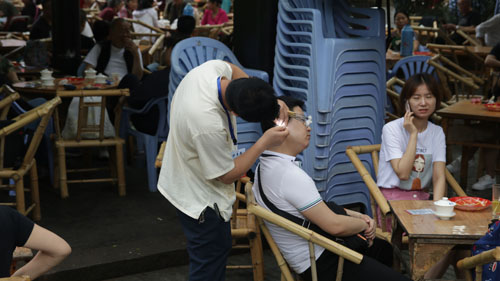 ,
where the take the metro into the city.
,
where the take the metro into the city.
Traveling by metro
Your luggage must be scanned at every metro station in China. Metro
tickets can be purchased from a vending machine. These are equipped
with a touch screen. There is always an "English" button. It is
important to know what your destination station is and on which line
it is. You first choose the line and then the station. Then the number
of tickets. Then choose the payment method "cash" and throw the money
in the machine. 5, 10 or 20 yuan coins or bills. The notes must not be
crumpled, otherwise they will be refused. In the metro station all
signs and the announcements are also in English. Transferring is made
easy by large arrows on the floor with the line number of the metro to
which you can transfer. On the platform you can see which direction
the metro is going to (end station) and what the next station is.
There is also an map of the entire line with all subsequent stations.
The platforms are separated from the tracks by a glass wall. There are
doors in the glass wall, in front of which the train doors of the
metro are precisely aligned. Before leaving the metro station it is
useful to know which exit you need. All exits have a letter
indication. There are also maps showing the exits and which
destinations you can reach with them (also in English). A movie
WeWe have to transfer three times and then end up at the Holiday
Inn Oriental Plaza . 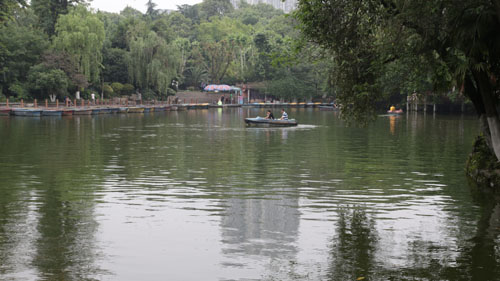 The
room is nice and spacious. We take a rest and then head for the Renmin
Park or the People's Park of Chengdu. This is a pleasant park in
the middle of the city with a large tea house with a terrace. We drink
tea there. It is surprising to see that the guests at the tea garden
have their ears cleaned by a specialist while drinking tea. We walk
around in the park. There a small boats on the lakes. Around noon we
have lunch in a Sichuan restaurant and eat delicious spicy pork and
vegetables. Then back to the hotel.
The
room is nice and spacious. We take a rest and then head for the Renmin
Park or the People's Park of Chengdu. This is a pleasant park in
the middle of the city with a large tea house with a terrace. We drink
tea there. It is surprising to see that the guests at the tea garden
have their ears cleaned by a specialist while drinking tea. We walk
around in the park. There a small boats on the lakes. Around noon we
have lunch in a Sichuan restaurant and eat delicious spicy pork and
vegetables. Then back to the hotel.
After a break we go by metro to the Wenshu monastery and temple.
This is a former monastery with a 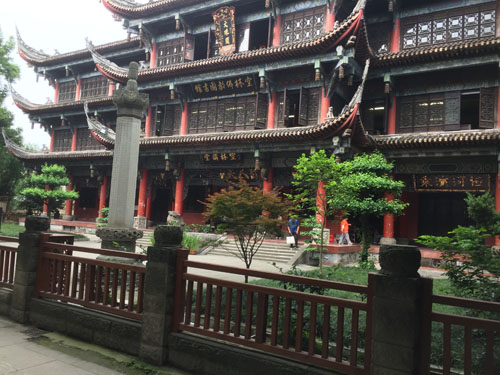 temple
that is still used by worshippers. It belongs to Zen branch of Buddhism,
the incarnation of wisdom. We walk around the gardens and temple
buildings of the complex. It is relatively quiet there, despite the many
people present. No problem with noisy smartphones this time.
temple
that is still used by worshippers. It belongs to Zen branch of Buddhism,
the incarnation of wisdom. We walk around the gardens and temple
buildings of the complex. It is relatively quiet there, despite the many
people present. No problem with noisy smartphones this time.
In the evening we eat in the hotel and drink coffee at a coffee and
pastry shop next door. A ballroom dance group is practicing on the
sidewalk. They dance a passo doble in formation to Chinese music. Nice
to see. We walk through the working-class area around the hotel. We look
at the shops, the pharmacy and the various eateries. We end the day with
a cocktail in the lobby bar. The cocktails are not very true to the
recipe. Apparently not all ingredients are available in China.
Weather: 26 degrees, cloudy
Thursday 18 May 2019
We get up early again. Today we are going to visit the Panda Bears
in the Giant Panda
Breeding and Research Base, which is located in Chengdu. The bears
are only active for a few hours in the morning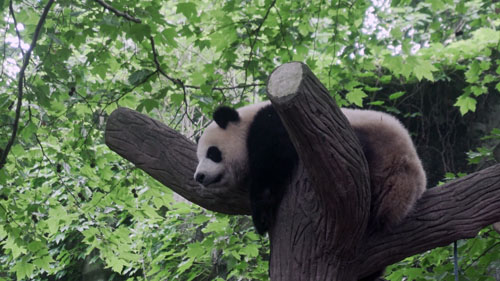 before they fall into a deep sleep. We take the metro to the North
station. We take a taxi from there. The taxi driver first tries to rip
us off by asking 80 RMB. We demand to switch on the meter. He then drops
to a ride price of 60 RMB. We agree. After a 50-minute drive, the meter
is indeed at 60 (€ 7.60). We get out in front of the huge entrance to
the center. There are large groups at the door, but we do not have to
wait for them. Due to his age, Erik can enter for free. I pay 55 RMB (7
euros).
before they fall into a deep sleep. We take the metro to the North
station. We take a taxi from there. The taxi driver first tries to rip
us off by asking 80 RMB. We demand to switch on the meter. He then drops
to a ride price of 60 RMB. We agree. After a 50-minute drive, the meter
is indeed at 60 (€ 7.60). We get out in front of the huge entrance to
the center. There are large groups at the door, but we do not have to
wait for them. Due to his age, Erik can enter for free. I pay 55 RMB (7
euros).
Once inside, we immediately go to the Giant Panda enclosure. There we
indeed see a number of large bears spending time lazing and eating
bamboo. They have a large living environment that is beautifully and
naturally landscaped. The bears do not really stay together but seek
solitude. They also live solitary in the wild. The bamboo is supplied in
large packages of bamboo sticks. The visitors are crowding around to
take the nicest photos. Mostly selfies with the bear in the background.
There are also Red Pandas. They belong to the raccoons and not to the
big bears. 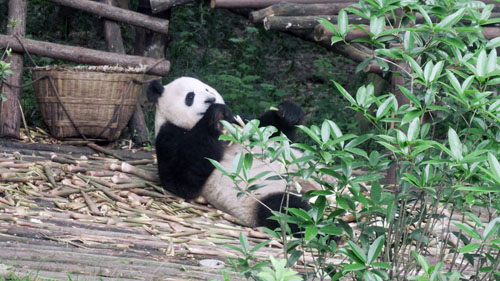 They
also eat bamboo. We drink a cappuccino in the panda cafe. A panda bear
has been artfully drawn in the milk foam. At the Panda delivery
enclosure, we hope to see baby bears, but that turns out to be a
disappointment. Apparently, there have been no births this spring.
They
also eat bamboo. We drink a cappuccino in the panda cafe. A panda bear
has been artfully drawn in the milk foam. At the Panda delivery
enclosure, we hope to see baby bears, but that turns out to be a
disappointment. Apparently, there have been no births this spring.
Around half past eleven we take the taxi back to the North Station and
with the metro back to the hotel. Surprisingly the ride back is much
shorter and half the price compared to this morning. After a break we go
for lunch in the area. We find nothing with an English-language menu,
but one with pictures on the menu. That is also a challenge, because
what is in the picture? We accidentally choose a dish with only
mushrooms and vegetables, but it tastes good and very spicy. Add some
rice. As a drink we take a beer, which comes in a litre glass, which
would put Bavaria to shame.
After lunch I have my hair trimmed at the hairdresser's. That is not
just a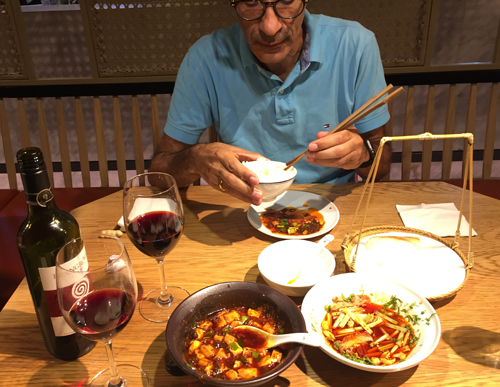 haircut. First I am extensively washed and massaged. This is followed by
trimming and cutting and then washing again. All this for 50 RMB (€
6.40).
haircut. First I am extensively washed and massaged. This is followed by
trimming and cutting and then washing again. All this for 50 RMB (€
6.40).
In the afternoon we take the metro to the Tibetan district. Because
Chengdu of the Chinese cities is closest to Tibet, many Tibetans who see
no future in Tibet go to Chengdu. They concentrate in a neighbourhood
south of Wuhu temple. There are many shops with carpets and Buddha
statues. There are also many Tibetan monks on the street. The
neighbourhood is also known as small Lhasa. There is also a lot of
police on the streets. Checkpoints are everywhere along the major
streets. Apparently, the authorities are apprehensive that the unrest in
Tibet could also spread to this place.
In the evening we eat at Ma's Kitchen (Ma Wang Zi) (since 1927), a very
popular Sichuan restaurant. There is a long line and we have to draw a
number. We can enter after more than an hour of waiting. There is a
waiter who speaks good English and he takes a care of us. We eat
deliciously, but also very spicy. The cuisine in this province is
notorious for that. Our lips are numbed by the time we have finished our
meal.
Weather: 28 degrees, sun